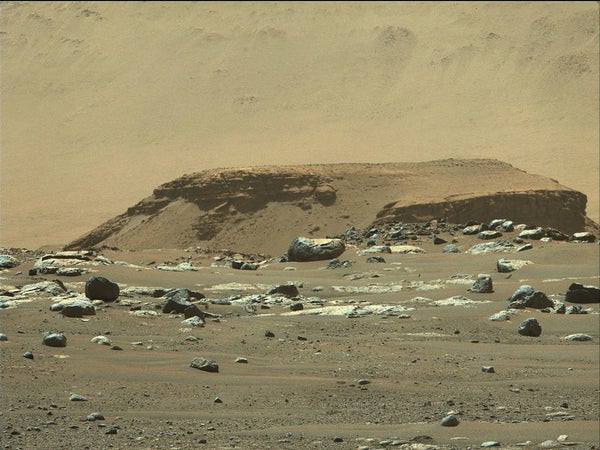For decades, the standard perception of Mars has been almost black-and-white in its simplicity—or rather red and blue: There is the barren, freeze-dried and rust-ruddy planet of today. And eons ago, there was a world warmer, wetter and more aquamarine with rivers, lakes, oceans and perhaps even life on its surface. In this red-and-blue view of Mars is much like a coin, with scientists questing to understand what caused the great planetary flip between its two opposing sides. Yet the closer they look, the clearer it is that this crude dichotomy cannot be entirely true: Mars, like Earth, is and always has been many worlds in one. The story of its habitability may be best understood not as a single, one-way global shift between red and blue but instead a series of hopscotch skips across a motley, regional patchwork of complex, changing conditions.
“It’s very easy to see Mars as one thing at one time,” says Matt Balme of the Open University, based in England. “But there were locations that were warm, wet, cold and dry, all at once.”
A research paper published today in the journal Science highlights this more nuanced view in exquisite detail. (Balme was not involved with the work.) It reports initial results from an in situ visual survey of the “Octavia E. Butler” landing site of NASA’s Perseverance rover, which touched down in Jezero Crater in February. Mission planners chose Jezero because orbital images suggested it harbors an ancient river delta and lake system sculpted by flowing water billions of years ago. Now analysis from Perseverance has not only confirmed this to be true but has also discovered short-lived episodes of sudden change that happened there.
On supporting science journalism
If you're enjoying this article, consider supporting our award-winning journalism by subscribing. By purchasing a subscription you are helping to ensure the future of impactful stories about the discoveries and ideas shaping our world today.
Co-led by Nicolas Mangold of the University of Nantes in France, the study team used images taken by Perseverance to examine the size, orientation and distribution of rocks strewn around the rover and embedded in sedimentary layers on exposed cliff faces and outcrops up to several kilometers away. The results show that 3.7 billion years ago, a river did indeed flow into this region at speeds of several meters per second, feeding a lake that filled the 45-kilometer-wide crater to depths as great as 100 meters in places. But the team’s analysis also revealed unexpected fluctuations in the lake’s depth, which appeared to occasionally rise or fall by several meters, possibly the result of seasonal variations. “There was a lake,” Mangold says, “but the story is different than expected.”
The most surprising characters in the story of Jezero so far were spied jutting from the delta’s fine-grained sediments: boulders more than a meter across that were worn round and smooth by long tumbles through Jezero’s river yet paradoxically too immense for any mere river to move. “They should not be there,” Mangold says. The explanation might be that, at some point, this region experienced extreme flooding in which the boulders and other debris were washed across great distances by walls of water cascading along the riverbed before a final plunge into the ancient lake. What might have caused floods of such magnitude is not clear, but on Earth, large amounts of melting ice or heavy precipitation can be the culprit behind such phenomena.
These boulders and their surrounding sediments could represent a fantastic opportunity to study material that originated far beyond Jezero’s perimeter, says Kirsten Siebach of Rice University, who was not involved in the paper. “Perseverance might be able to sample rocks that were really far upstream,” she says, referring to the rover’s key objective of retrieving specimens for future return to Earth.
A more active and extreme Martian hydrology was also described in a recent paper published in Nature by geologist Timothy Goudge of the University of Texas at Austin and his colleagues. That work showed that perhaps a quarter of the valley networks seen on Mars today could have been carved out on extremely short timescales by vast torrents of water rushing across the surface in episodes of catastrophic flooding. “Instead of carving the canyons over tens or hundreds of thousands of years, it would be on the order of weeks to months to maybe a few years,” Goudge says. “It’s sort of geologically instantaneous.”
Such violent, cataclysmic deluges may have been the bane of any organisms in their path, but they could be a boon for earthbound astrobiologists looking for their remains with a robotic rover. If anything ever did stir to life in the seemingly prime habitable conditions of Jezero’s river and lake, proof of its existence could have been preserved as the floodwaters rushed in, shielded from the ensuing eons of harsh surface conditions by a protective blanket of suddenly deposited sediments. “It means they’re shielded from radiation and not being weathered,” says Michael Meyer, lead scientist of NASA’s Mars Exploration Program at the agency’s headquarters in Washington, D.C. For Perseverance, these deposits inside the river delta could thus be one of the best locations to look for evidence of past life on Mars. “It’s a great target,” Meyers says.
What all this portends is nothing less than a new era in our otherworldly exploration. With each additional sign that Perseverance and other missions find of localized, transient events profoundly shaping parts of the Martian landscape, another colorful thread will be woven into the grand tapestry of the planet’s history. Whether in the welcoming blue of a clear crater lake or in the rushing red torrent of sediment-filled floods, our neighboring orb still has much to tell us. “We’re just starting to understand the complexities of Martian history,” Siebach says.
